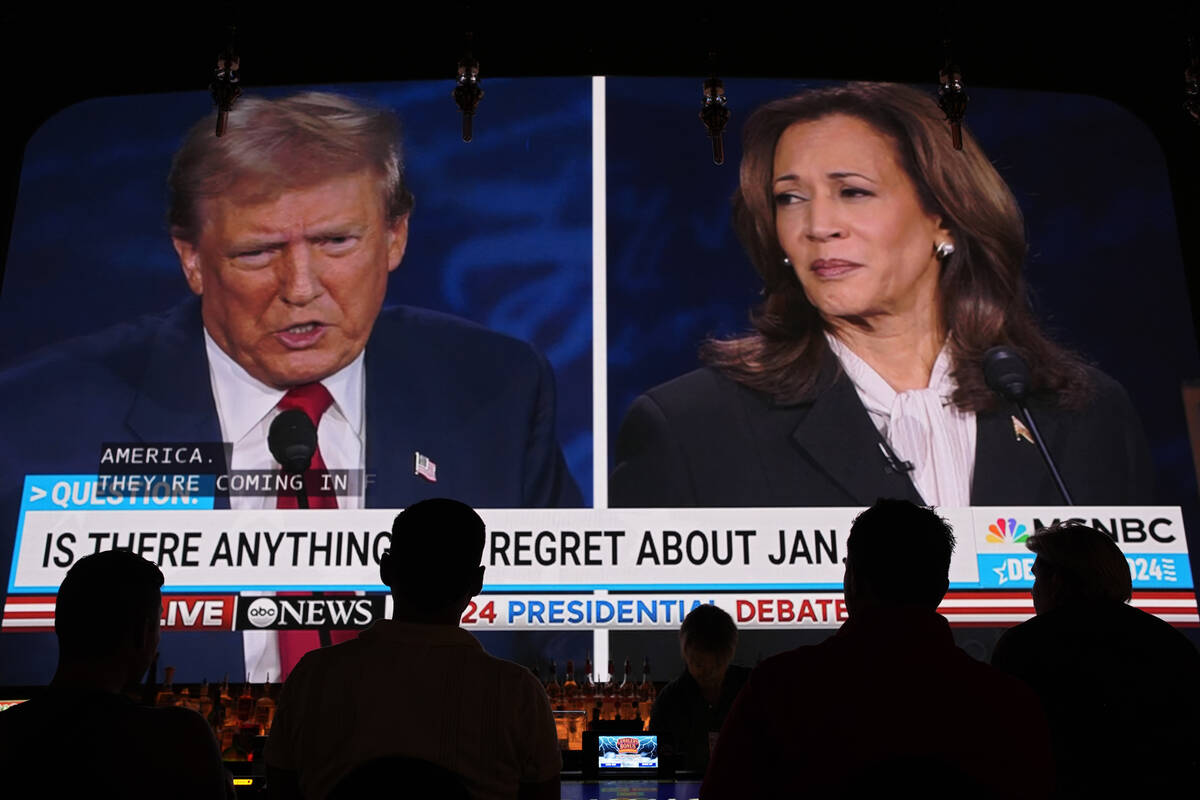Harris, Trump neck and neck in Nevada
Former President Donald Trump and Vice President Kamala Harris are neck and neck in the swing state of Nevada with less than two months to go until the November election, new polling shows.
A survey from Emerson College Polling/The Hill of voter attitudes in swing states released Thursday showed the candidates tied, each with 48 percent support in the Silver State, a marginal change from when the group last polled in late August before the presidential debate. That poll showed Harris at 49 percent and Trump at 48 percent.
In other swing states, Trump is ahead 50 percent to Harris’ 47 percent in Georgia and ahead by one point in Arizona and Wisconsin. Harris is ahead in North Carolina by one point and ahead in Michigan by two points. In Pennsylvania, Trump has 48 percent support and Harris has 47, according to the poll.
In Nevada, pollsters surveyed 895 Nevada likely voters, with a statistical error of plus or minus 3.2 percent. Of those participants, 288 were Democrats, 261 were Republican and 346 were independent or with another party. Twenty-one percent of respondents were 70 years old and up, with other age ranges each making up between 14 to 18 percent of respondents.
The latest polling offers clarity following independent presidential candidate Robert F. Kennedy’s withdrawal from the race in late August, and it shows his departure didn’t shift things too much one way or another, according to Dan Lee, a political science professor at UNLV. As political scientists wondered whether Harris’ “honeymoon period” would end after her successful campaign launch during the summer, the poll also shows her support has solidified, he said.
“Her support hasn’t dropped at all, and if anything, everything’s kind of holding steady in Nevada,” he said.
While Harris and Trump are tied in the Silver State among support, voters in Nevada expect Harris to be the next president. The poll asked regardless of who they support for president, which candidate they expect to win, and Nevada voters expect Harris to be the next president 50 percent to 48 percent.
Harris and Trump are also close when it comes to their favorability. Harris has a favorability rating of 50 percent and unfavorability rating of 51.3 percent. Trump also has a 50 percent favorability and unfavorability rating of 50.1 percent.
What does it mean?
The biggest takeaway from the poll is that the race is very close, and it’ll probably be that way come November, according to Kenneth Miller, a UNLV political science professor and polling expert.
Miller also explained the caveats with the Emerson College poll, and all public polling for that matter.
The Emerson College poll is aligned with a lot of other published public polls, Miller said. He emphasized the importance of distinguishing between public polls, which tend to operate on a shoestring budget and have a limited sampling methodology, and the private polls conducted by the parties and campaigns themselves that have much larger budgets.
Publicly available polls have historically gotten things wrong about Nevada’s elections, Miller said. In 2016, polls predicted then-Sen. Harry Reid would lose by 5 points, but he won; in 2016, polls underestimated Hillary Clinton in Nevada, he said.
“Relying on these publicly available low-budget polls is a fool’s errand in Nevada,” Miller said. “That leads me to the conclusion that it actually essentially ends up being the same conclusions with Emerson College — which is that this presidential race appears to be too close to call. It’s well within the range of survey error.”
Nevada is a difficult place to conduct surveys because of its diverse and transient populations, Miller said. A lot of people move in every couple of years, so the state’s electorate in any given election is not well-reflected in outdated voter registration data, he said.
When a survey reports a number, such as 47 percent to 45 percent, don’t think of it as a two-point lead; think of the race instead as a range around those numbers, Miller said.
It’s also important to think about polls’ cooperation rates, or the number of people who agree to participate in a survey out of every 100 people called, Miller said. Most public polls have a cooperation rate from 1.5 to 2.15 percent, he said.
“You have to ask yourself a lot of questions about how accurately representative of the overall population if the one out of 50 people who are willing to take time out of their day to cooperate in your survey,” he said.
The biggest issues, Nevada’s Senate race and the governor’s approval
The survey also asked voters the top issues facing their state. Nevada voters said the economy is the biggest issue, next to housing affordability. Threats to democracy, education, immigration and health care were also important.
In Nevada’s contentious Senate race, with more than $32 million spent, Democratic Sen. Jacky Rosen is ahead 48 percent to Republican Sam Brown’s 41 percent, with 9 percent of voters undecided. The Emerson College poll is consistent with other public polls on the Senate race that show Rosen ahead of Brown.
Lee said the Senate race is much closer than polls show. Rosen’s lead is exaggerated and will narrow as the campaign wears on, and there are many undecided voters who will vote for Brown, he said.
The survey also found that 39.8 percent approve of the job Gov. Joe Lombardo is doing, with 28.8 percent disapproving and 31.5 percent neutral or having no opinion.
Contact Jessica Hill at jehill@reviewjournal.com. Follow @jess_hillyeah on X.





















